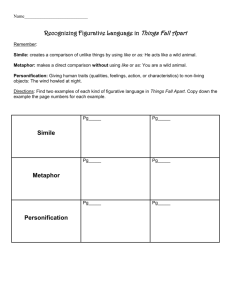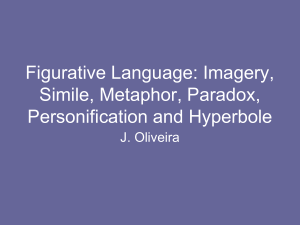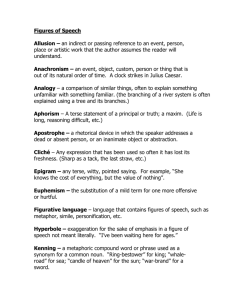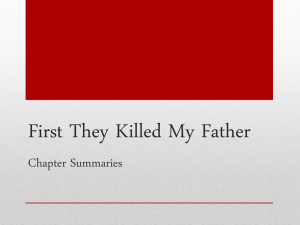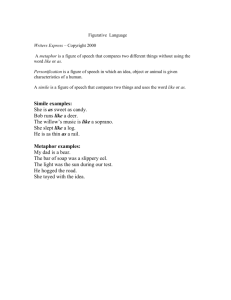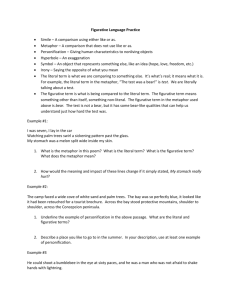From character to metaphor
advertisement
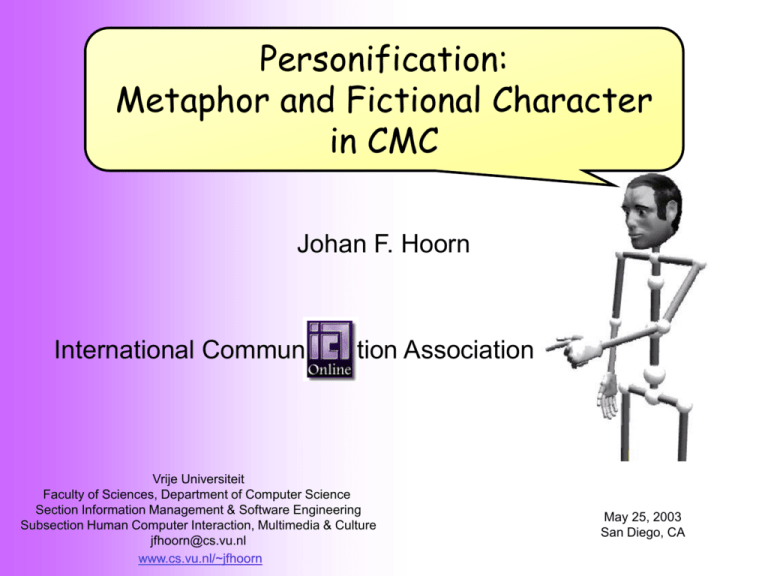
Personification: Metaphor and Fictional Character in CMC Johan F. Hoorn International Commun tion Association Vrije Universiteit Faculty of Sciences, Department of Computer Science Section Information Management & Software Engineering Subsection Human Computer Interaction, Multimedia & Culture jfhoorn@cs.vu.nl www.cs.vu.nl/~jfhoorn May 25, 2003 San Diego, CA Theory Personification, what is it? Personification Fictional character (Time, Cupid) used as a metaphor (Time is a man, Love is a boy) for an abstraction (Time, Love) Pierre Mignard (1694). Time Clipping Cupid’s Wings. Personification Fictional character (Robby) used as a metaphor (Human is machine) for an abstraction (Help, Search, Navigate) Software agents can be personifications Bill Gates (1997). Robby the Robot. No Personification Fictional character (Builder) used literally (Builder is a tutor) for an abstraction (Help, Instruct, Create) For this agent, the metaphoric aspect is missing RealTimeAide (2003). Building tutor. http://www.realtimeaide.com/tutor/tutor.htm Research question What’s the use of personification in CMC? Should we apply personifications? User effort Literal icon/dialog Metaphoric icon/dialog Mediated person/ Fictional character (FC) Personification (FC plus metaphor) Ease of understanding Motivation Fun Task relevance User support “Look and feel” Etc. Should we apply personifications? User effort Motivation Literal icon/dialog + (easy) - (no fun) Metaphoric icon/dialog - (difficult) + (surprising) Mediated person/ Fictional character (FC) - (build a ++ (involve- Personification (FC plus metaphor) -- relationship) ment) +++ Personification is more effort for more motivation? Theory Agents, what do they communicate? Agent-Mediated Communication Sender System’s stakeholder (e.g., client, designer, manager) Goals: - instruct - persuade - entertain Message Receiver End-user Fictional character + metaphor Match? Goals: - be instructed - be persuaded - be entertained Agent-Mediated Communication Sender System’s stakeholder (e.g., client, designer, manager) Receiver’s perspective Message End-user Fictional character Human processing PEFiC Goals: - instruct - persuade - entertain + metaphor Support user goals? yes Use agent Metaphor process no Don’t use agent Agent-Mediated Communication Sender’s perspective Message System’s stakeholder Receiver End-user (e.g., client, designer, manager) Alter agent no Goals: - instruct - persuade - entertain yes Support other goal? no Goals: - be instructed - be persuaded - be entertained Match? yes Maintain agent http://www.csc.ncsu.edu/eos/users/l/lester/www/images/IPA/cosmo_ok.gif Agent-Mediated Communication Sender Receiver’s perspective Message Perceiving and Experiencing Fictional Characters End-user Human processing PEFiC For empirical evidence, see and hear: Results of other studies Characters, how are they processed? ENCODE COMPARE Features of situation and Fictional Character Appraisal domains Ethics Epistemics Norm good dissimilar beautiful irrelevant realistic negative valence Mediators bad similar ugly relevant unrealistic positive valence Subjective norm vs. group norm PEFiC model Involvement % Aesthetics % RESPOND Fuzzy feature sets Distance Identification, empathy, sympathy, warm feelings, approach, etc. Appreciation Detachment, antipathy, cold feelings, avoidance, etc. Example of PEFiC in action for factor Relevance to user goals Involvement Peedy Relevant features if goal is ‘entertainment’ Task-irrelevant features (goal ‘instruction’) http://www.scpcug.com/wmwand12.html Distance From character to metaphor What is the role of epistemics? Agent-Mediated Communication Message Receiver’s perspective Race model of Metaphor Processing Part of Epistemics RMP For empirical evidence, see: End-user Human processing Metaphor is part of Epistemics ‘tutor is a human’ ‘human is a machine’ suit ‘conversation partner is a human’ ‘product presenter is a dog’’ drooling (saliva) feet drooling (too enthusiastic) constrained descriptive figurative descriptive figurative descriptive figurative descriptive figurative literal metaphor literal metaphor realistic ASSOCIATION unrealistic COMMUNICATION FORM EPISTEMICS http://www.ics.uci.edu/~kobsa/courses/ICS104/course-notes/metaphors.ht; http://www.techfak.uni-bielefeld.de/ags/wbski/lehre/digiSA/Methoden_der_KI/WS0102/methki15.pdf Results of other studies Metaphors, how are they processed? human Activate descriptive and figurative features machine yes Calculate descriptive intersection Race model of Metaphor Processing Category match? Activate descriptive and figurative features no EEG: N400 at frontal cortex Calculate descriptive/figurative intersection Sufficient descriptive AND descriptive/figurative intersection? no feet constrained ‘Anomaly’ Cosmo ‘Literal’ no Sufficient descriptive/figurative intersection? yes ‘Metaphor’ Discussion How come metaphors are harder to get but do not take more time? Errors are the answer Problem: Response times for literal and metaphor are about equal. No way telling whether these two information sources are serial or parallel Calculate descriptive intersection Calculate descriptive/figurative intersection (1) (2) If serial (1 before 2), applying metaphor is more time consuming and probably, more difficult to understand If parallel, metaphor can be applied without losing time-efficiency and trouble of understanding ‘Literal’ no Sufficient descriptive/figurative intersection? yes ‘Metaphor’ Solution: Investigate Lateralized Readiness Potential (LRP) in response to partial error pattern (after Coles et al., 1995) Calculate descriptive intersection (1) Few errors for ‘Metaphor’ ‘Literal’ Thus, speed is not the difficulty in metaphor but accuracy is Calculate descriptive/figurative intersection (2) Many errors for ‘Literal’ invisible in behavioral measures (e.g., RT) because they are corrected before response execution visible in EEG ‘Metaphor’ For full argumentation, see: Predictions for contralateral effects of finger movement during metaphor processing (fictitious data) Partial error ‘Literal’ Correct ‘Metaphor’ LRP high LRP low motor cortex stimulus onset stimulus onset stimulus response buttons ‘Metaphor’ ‘Literal’ Shall we apply personifications, then? high User effort Motivation + (easy) - (no fun) high Literal icon/dialog N400 (surprise) Two information sources: - descriptive - descriptive/figurative Time efficiency Metaphoric Categoryicon/dialog mismatch PEFiC RMP - (difficult) + (surprising) Mediated person/ Fictional character (FC) - (do I like the ++ (personal Personification (FC plus metaphor) -- Error prone (LRP) Appreciation (Fun) Task relevance Valence (User support) Aesthetics (“Look and feel”) Ethics (Good bot vs. bad bot) Epistemics (Graphic rendering) Similarity (cf. Avatars) Involvement-distance character?) -ized) +++ Personification is more effort for more motivation Future work We developed a software package for testing existing and newly created agents: Stimulus and trial production, RTs, and in the future, questionnaires and EEG extensions. Downloads: http://www.antbed.tk/ What is it? What can you do with it? Action preview Create environments in PowerPoint and let the agent do its actions Personification: THE END Character Metaphor and Fictional in CMC Wanna know more? Visit www.cs.vu.nl/~jfhoorn
